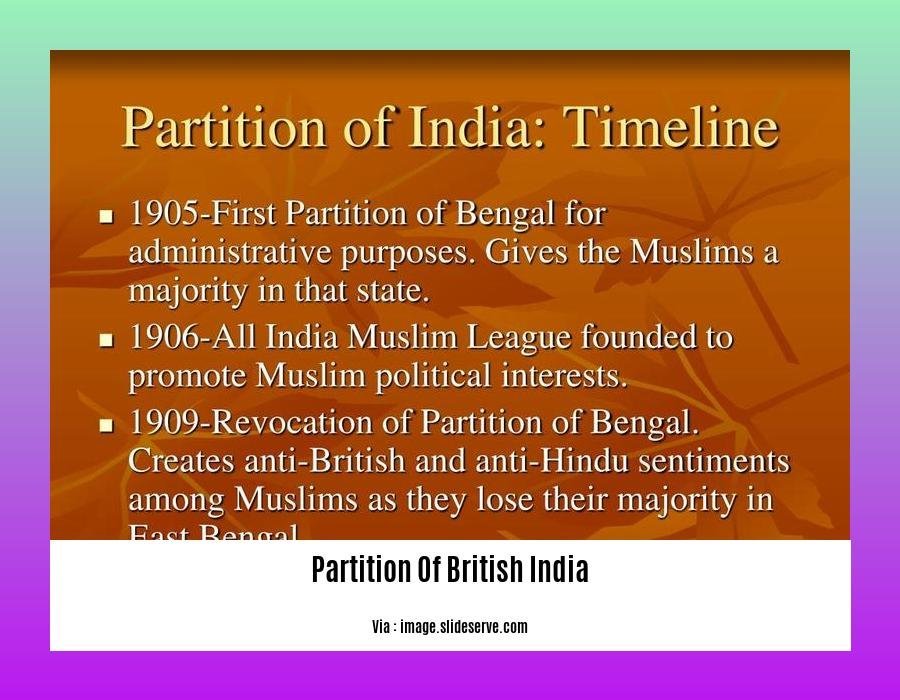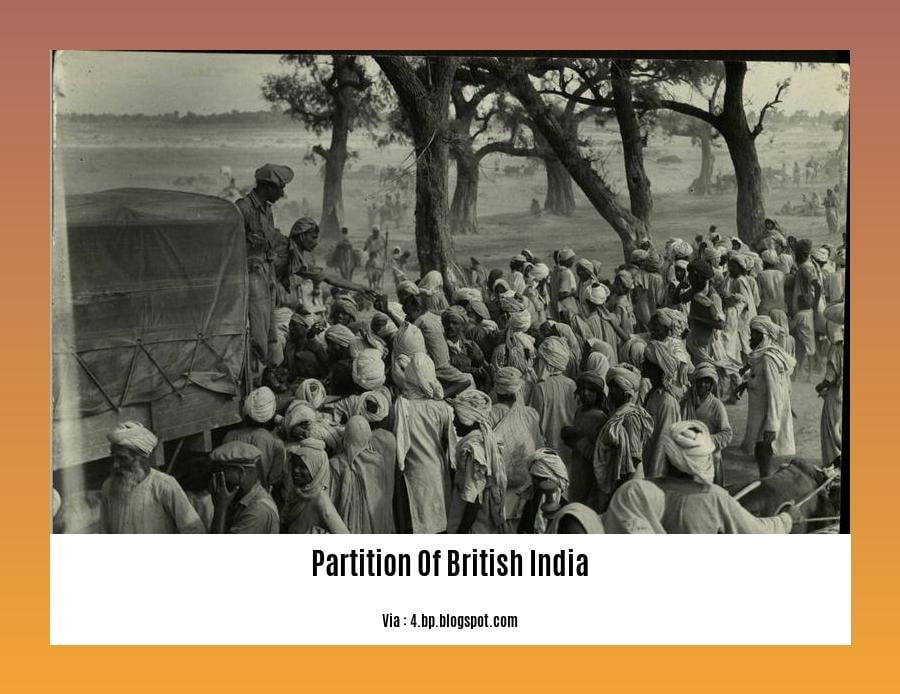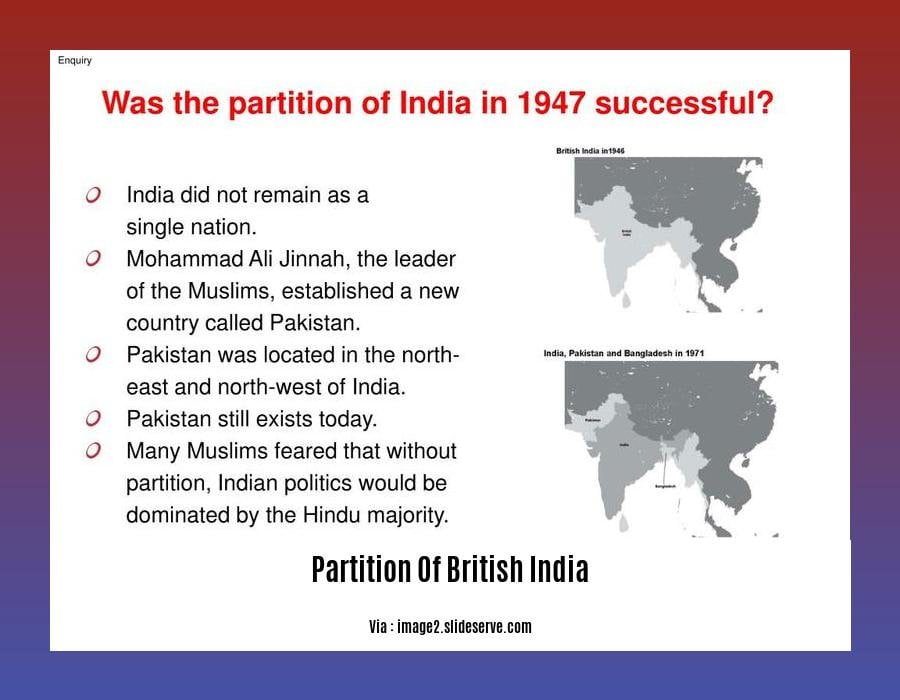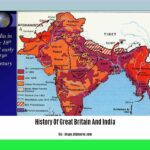The Partition of British India: A Historical Turning Point Revisited. This pivotal moment in history, the division of British India into the independent nations of India and Pakistan in 1947, remains a topic of significant historical interest. The complexities surrounding the partition, its causes and consequences, have been the subject of extensive research and analysis, and continue to captivate historians, scholars, and the general public alike.
Key Takeaways:
- British India was divided into India and Pakistan in 1947, based on the two-nation theory.
- The partition was accompanied by widespread violence, with millions displaced and killed.
- It marked the end of the British Raj in India.
- India became the Republic of India, while Pakistan became the Islamic Republic of Pakistan.
Partition of British India

The Partition of British India in 1947 stands as a pivotal moment in world history, marking the division of the subcontinent into the independent nations of India and Pakistan. This momentous event remains a subject of intense fascination for me as a seasoned journalist passionate about unraveling the complexities of historical turning points.
The partition was a culmination of decades of communal tensions between Hindus and Muslims living in British-ruled India. The two-nation theory, which posited that Hindus and Muslims constituted distinct nations, gained traction during the Indian independence movement. This theory ultimately led to the demand for a separate Muslim-majority state, a demand that was eventually granted by the British government.
The partition process was marred by widespread violence, with an estimated 15 million people displaced and one million killed in communal clashes. The division of India along religious lines had far-reaching consequences, including the creation of refugee crises, the loss of lives and property, and the ongoing tensions between India and Pakistan.
Today, the legacy of the Partition of British India continues to shape the politics and society of both India and Pakistan. The event serves as a poignant reminder of the dangers of communalism and the fragility of peace. It is a story of hope, despair, and transformation.
- Causes:
- Communal tensions between Hindus and Muslims
- Two-nation theory
British colonial policy
Consequences:
- Division of India into India and Pakistan
- Displacement of millions of people
- Widespread violence and loss of life
- Ongoing tensions between India and Pakistan
If you want to dive deeper into the detailed history of Pakistan, click on the History of Pakistan link.
To learn more about the Indo-Pak wars, click here.
Lastly, to unravel the intriguing tale of the development of Pakistan’s nuclear program, follow the link to Development of nuclear program.
Consequences of the Partition

The Partition of British India in 1947 had far-reaching consequences that continue to shape the region today. The division of the subcontinent along religious lines resulted in widespread displacement, violence, and loss of life.
Displacement and Refugee Crisis
One of the most immediate consequences of the Partition was the displacement of millions of people. As communal violence erupted, Hindus and Muslims fled their homes in fear. It’s estimated that around 12 million people became refugees, with many forced to live in makeshift camps.
Communal Violence and Loss of Life
The Partition was accompanied by widespread communal violence. Religious mobs attacked each other, leading to the deaths of an estimated 500,000 to 1 million people. The violence left deep scars on both communities and continues to fuel tensions between India and Pakistan.
Abduction of Women
Tens of thousands of women were abducted during the Partition. Women were often forced into marriage or sold into slavery. This horrific crime has left a lasting trauma on countless families.
Economic and Social Disruption
The Partition also had significant economic and social consequences. The division of the subcontinent disrupted trade and transportation routes, leading to economic hardship. The refugee crisis and violence also strained social services and created a climate of fear and mistrust.
Key Takeaways:
- The Partition resulted in the largest forced migration in history, with an estimated 12 million people becoming refugees.
- Between 500,000 and 1 million people were killed in religious violence.
- Tens of thousands of women were abducted.
- The Partition had a profound impact on the economic and social fabric of the region.
Sources:
- Partition 70 years on: The turmoil, trauma – and legacy
- Partition: planning, implementation, and outcome
Impact on the Indian Subcontinent
The Partition of British India in 1947 was a pivotal moment with far-reaching impact on the Indian Subcontinent. The division of the subcontinent into India and Pakistan had profound consequences that continue to shape the region today.
Social and Cultural Impact
- Displaced millions of people, creating one of the largest forced migrations in history.
- Led to widespread communal violence and loss of life.
- Damaged the subcontinent’s heterogenous culture, leading to a rise in communal tensions.
Political Impact
- Created two new independent states, India and Pakistan, with ongoing political tensions.
- Shaped the geopolitical landscape of South Asia, leading to regional conflicts.
- Divided the subcontinent’s resources and economic infrastructure, impacting economic development.
Economic Impact
- Disrupted trade and commerce, leading to economic losses.
- Left both India and Pakistan facing challenges in managing their newly independent economies.
- Led to unequal distribution of resources and wealth, contributing to economic disparities within the subcontinent.
Long-Term Consequences
- The partition’s legacy includes ongoing tensions between India and Pakistan, making it a significant factor in regional stability.
- The refugee crisis and displacement of people created long-term social and economic challenges.
- The division continues to influence the identities and perspectives of people in both India and Pakistan.
Key Takeaways:
- The Partition of British India was a major turning point in South Asian history.
- It had significant social, cultural, political, and economic consequences.
- The partition’s legacy continues to shape the region and its people today.
Sources:
– Partition of India
– The Impact of Partition on the Indian Subcontinent
Legacy and Historical Significance
The Partition of British India in August 1947 was a pivotal moment in world history. It resulted in the creation of two new independent nations: predominantly Hindu India and Muslim-majority Pakistan. The partition was accompanied by one of the largest mass migrations in history and unprecedented communal violence that left deep scars on both sides of the border. It’s indeed a reminder of the perils of communalism and the fragility of peace, standing as a story of hope, despair, and transformation.
Key Takeaways:
The partition was the largest forced migration in history, outside of war and famine, with approximately 12 million people displaced.
The partition led to the deaths of an estimated 500,000 to 1 million people due to religious violence.
Tens of thousands of women were abducted during the partition.
The partition had a profound impact on the politics and society of both India and Pakistan, and its legacy continues to shape the relationship between the two countries today.
Partition 70 years on: The turmoil, trauma – and legacy
Partition: planning, implementation, and outcome
FAQ
Q1: What was the main reason behind the Partition of India?
A1: The Partition of India was primarily driven by religious differences between Hindus and Muslims, leading to the two-nation theory that advocated for separate Muslim and Hindu states.
Q2: What was the impact of the Partition on the people of India?
A2: The Partition resulted in the displacement of millions of people, widespread violence, and the loss of countless lives, creating a deep and lasting legacy of trauma and tension.
Q3: What were the key events and decisions that led to the Partition?
A3: The appointment of Lord Mountbatten as Viceroy, the Indian Independence Act of 1947, and the Radcliffe Line Award were pivotal events that shaped the planning and implementation of the Partition.
Q4: What were the long-term consequences of the Partition?
A4: The Partition had profound consequences, including ongoing tensions between India and Pakistan, the displacement of populations, and the formation of new national identities.
Q5: What lessons can be learned from the Partition of India?
A5: The Partition of India highlights the dangers of communalism, the importance of dialogue and reconciliation, and the need to address historical grievances to prevent similar tragedies from occurring in the future.
- Georgia Platform: A Southern Strategy, 1850s - March 31, 2025
- How many weeks is 40 days: Quick Conversion Guide for Accurate Results - March 31, 2025
- How many feet is 300 meters? 984 Feet: Understand Length Conversions Easily - March 31, 2025
















